News Archives : 2010
Yang Zhang awarded Clifford G. Shull Fellowship from Oak Ridge National Laboratory (ORNL)
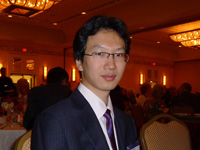 Recent Nuclear Science and Engineering graduate student Yang Zhang has been awarded the prestigious 2010 Clifford G. Shull Fellowship at Oak Ridge National Laboratory.
Recent Nuclear Science and Engineering graduate student Yang Zhang has been awarded the prestigious 2010 Clifford G. Shull Fellowship at Oak Ridge National Laboratory.
At MIT, Yang and his adviser Professor Sow-Hsin Chen investigate the unusual phase behavior of supercooled water in confined geometry, such as nanoporous materials and the vicinities of various biomolecular surfaces. Their recent neutron scattering experiments on the measurement of the equation of state of confined water may help understand the origin of the peculiar properties of water. At ORNL, Yang will expand his interests to study the physics of general amorphous materials.
The Clifford G. Shull Fellowship honors Clifford G. Shull, a former professor at MIT and the corecipient of the 1994 Nobel Prize in Physics, for his pioneering work in neutron scattering. The goal of this fellowship is to attract young investigators of exceptional ability who show clear and definite promise of becoming outstanding leaders in neutron sciences. Shull fellows are sponsored by the Neutron Scattering Science Division, which manages scientific activities at both the Spallation Neutron Source (SNS) and the High Flux Isotope Reactor (HFIR) at ORNL. Fellowships are two-year appointments, renewable for a third. It is anticipated that this program will provide an opportunity for the Shull fellows to develop innovative research programs and derive significant professional accomplishments.
How liquids behave
 Researchers identify a fundamental property of how water and other liquids behave
Researchers identify a fundamental property of how water and other liquids behave
as their temperature changes.
In a finding that has been met with surprise and some controversy in the scientific community, researchers at MIT and elsewhere have discovered a basic property that governs the way water and many other liquids behave as their temperature changes.
Liquids have long been known to exhibit a rapid change in properties near a point called the glass transition temperature, where the viscosity of the liquid — its "thickness," or resistance to flow — becomes very large. But MIT professor Sow-Hsin Chen and his co-researchers have found a different transition point at a temperature about 20 to 30 percent higher, which they call the dynamic crossover temperature. This temperature may be at least as important as the glass transition temperature, and the viscosity at the dynamic crossover temperature seems to have a universal value for a large class of liquids (called glass-forming liquids) that includes such familiar substances as water, ammonia and benzene.
A step toward fusion power
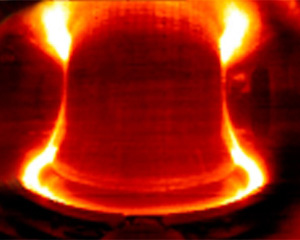 MIT advance may help remove contaminants that slow fusion reactions, and could be significant in enabling the next step towards practical fusion power plants.
MIT advance may help remove contaminants that slow fusion reactions, and could be significant in enabling the next step towards practical fusion power plants.
The long-sought goal of a practical fusion-power reactor has inched closer to reality with new experiments from MIT's experimental Alcator C-Mod reactor, the highest-performance university-based fusion device in the world.
The new experiments have revealed a set of operating parameters for the reactor — a so-called "mode" of operation — that may provide a solution to a longstanding operational problem: How to keep heat tightly confined within the hot charged gas (called plasma) inside the reactor, while allowing contaminating particles, which can interfere with the fusion reaction, to escape and be removed from the chamber.
Professors Yet-Ming Chiang and Richard Lester appointed to DOE Energy Advisory Committee
Committee to provide advice and expertise on clean energy issues under the Office of Energy Efficiency and Renewable Energy
Washington, D.C., November 12 2010
The U.S. Department of Energy today announced the establishment of the Energy Efficiency and Renewable Energy Advisory Committee (ERAC). ERAC is a federal advisory committee whose members will report directly to the Secretary of Energy with advice on the portfolio of the Office of Energy Efficiency and Renewable Energy (EERE). The 19 members selected have experience in a variety of sectors and will bring a range of technical expertise and perspectives to the committee. Two of the committee members are MIT Professors Yet-Ming Chiang, Kyocera Professor of Ceramics at the Department of Materials Science and Engineering; and Richard Lester, Japan Steel Industry Professor and Head of the Department of Nuclear Science and Engineering, and Co-chair, Industrial Performance Center
”We are fortunate to have such knowledgeable people volunteering their time and efforts to the Department's clean energy endeavors," said Secretary Chu. "They will be contributing their expertise and experience to help address the energy challenges faced by our Nation.”
ERAC will periodically review EERE's portfolio and provide advice to the Secretary of Energy on a variety of areas including: completion of long-range plans, priorities and strategies; program funding; and any issues of specific concern expressed by the Secretary of Energy or the Assistant Secretary for EERE. ERAC is expected to meet twice a year; the meetings will be open to the public. The Committee is being established in accordance with the Federal Advisory Committee Act (FACA). DOE also expects to organize various subcommittees under ERAC.
John Holdren sees opportunities in energy challenges
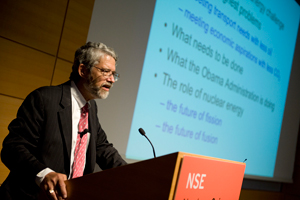 The two toughest challenges the nation faces in terms of energy, according to presidential science adviser John Holdren '65 SM '66, are meeting our transportation needs with less oil, and meeting economic aspirations while producing less climate-altering carbon-dioxide emissions. But the good news, he told an MIT audience on Monday, Oct. 25, is that meeting those challenges really can promote significant job creation and business growth.
The two toughest challenges the nation faces in terms of energy, according to presidential science adviser John Holdren '65 SM '66, are meeting our transportation needs with less oil, and meeting economic aspirations while producing less climate-altering carbon-dioxide emissions. But the good news, he told an MIT audience on Monday, Oct. 25, is that meeting those challenges really can promote significant job creation and business growth.
Holdren, delivering the David J. Rose Lecture in Nuclear Technology, noted that as of 2008, 82 percent of the world's energy needs were being met through the use of fossil fuels — a degree of dependence he called “shocking.” And the percentage of fossil-fuel dependence is even higher in the United States and China, he said.
NSE graduate student wins NuMat award
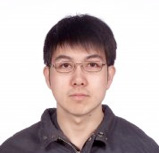
NSE graduate student Yue Fan won the Young Scientist Best Presentation Award at the Nuclear Materials Conference (NuMat) for his paper entitled Microstructural Evolution of Vacancy Clusters in bcc Fe: Kinetics at the Experimental Time Scales. The award, for originality of the research and quality of the presentation, was presented at the inaugural NuMat held on 4-7 October 2010, in Karlsruhe, Germany.
The paper was co-authored with Akihiro Kushima and Profs. Sidney Yip and Bilge Yildiz of the Department of Nuclear Science and Engineering. It discusses a new approach at the atomic scale to predict irradiated microstructure evolution at long time scales, beyond the reach of traditional atomistic simulations.
NuMat, formed in association with Journal of Nuclear Materials, serves as an umbrella for international meetings on nuclear materials science for fission reactors, including the nuclear fuel cycle and is intended to be an international key scientific forum in the field.
Professor Bilge Yildiz appointed to the Rasmussen Chair in Nuclear Science and Engineering
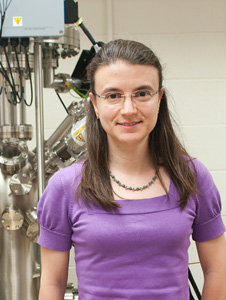
Assistant Professor Bilge Yildiz has been named Norman C. Rasmussen Assistant Professor of Nuclear Science and Engineering. The two-year Rasmussen professorship is a career development chair, designed to give younger faculty members an opportunity to establish their research activities and lay the foundation for future advances in their field.
Professor Yildiz's research focuses on understanding the fundamental relations between surface structure, microchemistry, electronic structure and activity in electrochemically-active material interfaces. By elucidating the mechanisms governing interface reactivity at the atomistic level, Professor Yildiz and her colleagues hope to be able to tailor these interfaces to the benefit of particular technologies of interest, including both future generations of fuel cells and corrosion-resistant alloys in nuclear reactors.
The Rasmussen Professorship was endowed by Institute alum Neil Rasmussen in honor of his late father, Norman C. Rasmussen, a pioneering and widely-admired NSE professor who served as department head from 1975 to 1981. Professor Rasmussen was lead author of WASH-1400, the influential 1975 report for the Nuclear Regulatory Commission which marked the first application of probabilistic risk assessment (PRA) to nuclear plant safety.
Three NSE students awarded DOE-funded Science Graduate Fellowships
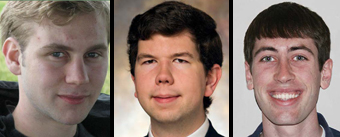
Current NSE graduate student Christian Haakonsen and incoming students Mark Chilenski and John Hanson are among 15 MIT students awarded Science Graduate Fellowships by the Department of Energy's Office of Science. The fellowship is part of a new initiative to encourage outstanding students to choose careers in science and to support basic research by young scientists in a variety of fields including biology, chemistry, physics, computational science, engineering, environmental sciences, and mathematics.
Christian Haakonsen's interests range from plasma physics and fusion energy to neutron stars. He is currently engaged in research that explores using particle-in-cell codes to study ion-collecting probes/objects in flowing magnetized plasmas.
Mark Chilenski's graduate research will focus on the Levitated Dipole Experiment (LDX), a unique plasma confinement device that uses an inductively charged, magnetically levitated superconducting magnet in the middle of the plasma to provide a poloidal magnetic dipole field. John Hanson's research interests lie in energy policy and solutions to the nation's energy challenges. He will focus on the advancement of nuclear power as an integral part of the future energy solution. Mark Chilenski and John Hanson will join the Department in Fall 2010.
This is the first year of DOE's Science Graduate Fellowship Program, which will support 150 students nationwide. “The exceptionally talented students selected as graduate fellows are part of our nation's next generation of scientific and technical leaders,” said DOE Secretary Chu. “This investment in the training of scientists and engineers is part of the Administration's continued effort to ensure that America has the scientific and engineering workforce we need to secure our energy future and our continued economic competitiveness.” Each fellow will be provided $50,500 per year for up to three years to support tuition, living expenses, research materials and travel to research conferences or to Department of Energy scientific user facilities.
L to R: DOE Science Fellows, Christian Haakonsen, Mark Chilenski and John Hanson.
Three NSE graduate students win DOE-sponsored awards
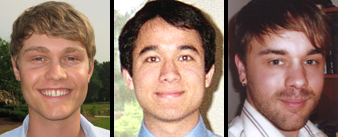
Graduate students Mark Massie, Robert Petroski, and Jeremy Roberts, of the Department of Nuclear Science and Engineering, have been named winners of the 2010 Innovations in Fuel Cycle Research Awards sponsored by the Department of Energy (DOE). This new award program is designed to facilitate innovation, the creation of new ideas, and education in fuel-cycle-relevant disciplines. Students were judged on published or submitted papers in any of the following eight categories: Nuclear Science and Engineering, Fuel Separations and Waste Forms, Advanced Materials, Nuclear Fuels, Isotope Transmutation, Nuclear Material Accountability and Control Instrumentation, Systems Engineering and Analysis, and Energy Policy (with a focus on Nuclear Energy). Robert Petroski and Mark Massie placed first and second respectively in the Isotope Transmutation category; Jeremy Roberts placed second in the Nuclear Science and Engineering category. All three will receive cash prizes and will present their work at the 2010 ANS Winter Meeting.
L to R: Award winners, Mark Massie, Robert Petroski, and Jeremy Roberts.
NSE Prof. Ronald Ballinger appointed to the MWRA Independent Review Panel
On June 29, 2010, the Board of Directors of the Massachusetts Water Resource Authority (MWRA) appointed a three-member independent panel of experts that will examine the circumstances that led to the loss of the insulating coupling along a section of the MetroWest Water Supply Tunnel. This failure resulted in a boil water order for 30 Eastern Massachusetts communities.
The expert panel is chaired by President Zorica Pantic, President of Wentworth Institute of Technology. It includes Ronald Ballinger, Professor of Nuclear Science and Engineering and Materials Science and Engineering at MIT and Director of the H. H. Uhlig Corrosion Laboratory; and John H. Bambei, Jr. Chief of Engineering for Denver Water and Chairman of the American Waterworks Associations' Committee on Steel Pipe. This independent review panel will prepare a report of its findings and recommendations about the design, construction and other defects or deficiencies that may have contributed to the failure of the affected section of the tunnel. It will include any evidence that may allow MWRA to pursue cost recovery efforts, and will also make general recommendations about the design, installation and testing of past and future pipe coupling systems.
Former nuclear engineering head Mason dies at 85
 Edward A. Mason, a former head of the Department of Nuclear Engineering, died at his home in Osterville, Mass., on June 23. He was 85.
Edward A. Mason, a former head of the Department of Nuclear Engineering, died at his home in Osterville, Mass., on June 23. He was 85.
Mason joined the faculty of the Nuclear Engineering Department at its formation in 1957, having previously served as an Assistant Professor of Chemical Engineering. He served as department head from 1971 to 1975.
He was a U.S. Navy veteran, and received his master's and doctorate degrees in chemical engineering from MIT after serving in World War II.
In 1974 President Gerald Ford appointed Mason as a commissioner on the first Nuclear Regulatory Commission. He began his government service in January 1975, when the Commission was formally established. He subsequently served as Vice President for Research at Amoco Corporation. Mason was a member of the National Academy of Engineering and the New York Academy of Sciences; fellow of the American Academy of Arts and Sciences, American Nuclear Society, and the American Institute of Chemists; and member of the American Institute of Chemical Engineers, the American Chemical Society, and the American Association for the Advancement of Science.
Richard K. Lester, the current head of the Nuclear Science and Engineering department, noted the influential role played by Mason in the early years of the department. “Ed was an outstanding figure in the development of the nuclear engineering discipline. Together with Manson Benedict and their students he shaped the field of nuclear chemical engineering. And even after leaving the Department Ed continued over many years to provide valuable advice and counsel to us. He will be greatly missed.”
MIT partners in DOE-funded Nuclear Energy Innovation Hub
MIT is one of nine partners in a new Nuclear Energy Innovation Hub announced by U.S. Deputy Secretary of Energy Daniel Poneman on May 28. The Hub, also known as the Consortium for Advanced Simulation of Light Water Reactors (CASL), will be led by Oak Ridge National Laboratory, and in addition to MIT includes partners from universities, industry and other national labs. It will use advanced capabilities of the world's most powerful computers to make significant leaps forward in nuclear reactor design and engineering. A major focus of the MIT researchers will be to model the behavior of key materials such as fuel and fuel cladding together with energy generation and transport processes so as to provide better estimates of how these materials will perform within the extreme environment of a nuclear reactor. The Nuclear Energy Innovation Hub will receive up to $122 million over five years and is the first of three Hubs expected to be announced by the Department of Energy this year.
The MIT team is led by three Nuclear Science and Engineering professors: the PI, Professor Mujid Kazimi, Director of the Center for Advanced Nuclear Energy Studies, and the co-PIs, Professors Sidney Yip and Jacopo Buongiorno. The Oak Ridge-based Innovation Hub will be guided by a Board of Directors headed by Professor Ernest Moniz of the MIT Energy Initiative on which Prof. Kazimi will also serve. The MIT team brings together faculty and research staff from Nuclear Science and Engineering (Profs. Benoit Forget and Bilge Yildiz and Dr. Aydin Karahan, as well as Profs. Kazimi, Yip, and Buongiorno), Materials Science and Engineering (Profs. Michael Demkowicz and Jeff Grossman), and Civil and Environmental Engineering (Prof. John Williams).
Bill Gates: I love nuclear
During his recent visit to MIT, Bill Gates asked an audience of students and faculty a basic question: "Are the brightest minds working on the most important problems?" While his talk focused on health care in the developing world and the U.S. education system, in the question session that followed the discussion shifted to the future of energy.
Matthew R. Denman, a graduate student in the Department of Nuclear Science and Engineering, asked Gates about the future of nuclear power, referring to TerraPower, a company with a design for a new kind of reactor using depleted uranium in which Gates is a lead investor.
Gates firmly declared himself to be pro-nuclear—"the coolest of all". He contrasted nuclear technology with what he called "cuddly" technologies like wind and solar, which require large amounts of land and generate energy only intermittently. "I love nuclear ..." he said, and called for more innovation in nuclear power plants.
One of the biggest challenges facing the nuclear engineers at TerraPower and throughout the nuclear power industry is to develop materials, including fuels, that are capable of performing efficiently and reliably in high radiation fields over long periods. At NSE several faculty are working on materials-related problems in radiation environments, in some cases in collaboration with colleagues in the Department of Materials Science and Engineering.
In NSE Sidney Yip, Bilge Yildiz, Ron Ballinger, Mujid Kazimi, Jacopo Buongiorno, Dennis Whyte
In DMSE Linn Hobb, Michael Demkowicz
Prof. George Apostolakis sworn in as Commissioner of NRC
Nuclear Regulatory Commission Chairman Gregory B. Jaczko today administered the oath of office to the newest Commissioner, Dr. George Apostolakis, in a ceremony at NRC headquarters in Rockville, Md.
The addition of Apostolakis, a professor of nuclear science, brings the agency to its full complement of five commissioners for the first time since 2007. He joins the other Commissioners Kristine L. Svinicki, William D. Magwood and William C. Ostendorff. Both Magwood and Ostendorff were sworn in April 1.
“I'm looking forward to the Commissioner joining our discussions about important policy issues facing the agency and the nation,” said Jaczko. “He brings an exceptional background and talent to the NRC. His insights and experience will strengthen our decision-making and help us to continue to meet our critical mission to protect public health, safety and the environment.”
“Nuclear safety has been at the center of my career and I look forward to working with my fellow commissioners to shape policy on the important regulatory issues facing the agency,” said Apostolakis, who is a former member and chairman of the statutory Advisory Committee on Reactor Safeguards at the NRC.
Before joining the NRC, Apostolakis was the Korea Electric Power Corporation professor of Nuclear Science and Engineering and a professor of Engineering Systems at the Massachusetts Institute of Technology. He is the founder of the International Conferences on Probabilistic Safety Assessment and Management and received the Tommy Thompson Award for his contributions to improvement of reactor safety in 1999 and the Arthur Holly Compton Award in Education in 2005 from the American Nuclear Society. He was elected to the National Academy of Engineering in 2007.
The NRC commissioners have five-year terms, each staggered one year apart. Apostolakis was confirmed to a term that ends June 30, 2014.
NSE Alum Roderic I. Pettigrew, Ph.D. ‘77, elected to the National Academy of Engineering
Roderic I. Pettigrew, Director of the National Institute of Biomedical Imaging and Bioengineering, has been elected to the National Academy of Engineering. Dr. Pettigrew was recognized for “the use of MRI in human blood-flow studies and leading advancements in bioengineering research and education as the initial director of NIBIB.”
Dr. Pettigrew received his Ph.D. in Nuclear Engineering from MIT in 1977, and was a student of the late Professor Gordon Brownell. He subsequently received an M.D. from the University of Miami School of Medicine in an accelerated two-year program, served an internship and residency in Internal Medicine at Emory University, and completed his residency in Nuclear Medicine at the University of California, San Diego. Dr. Pettigrew then spent a year as a Clinical Research Scientist with Picker International, the first manufacturer of MR equipment. In 1985, he joined Emory as a Robert Wood Johnson Foundation Fellow focusing in non-invasive cardiac imaging.
A renowned physician and nuclear physicist, Dr. Pettigrew is well known for his pioneering research involving four-dimensional imaging of the heart using magnetic resonance imaging. He has been a Professor of Radiology Medicine (Cardiology) at Emory University, as well as Professor of Bioengineering at the Georgia Institute of Technology. He also served as Director of the Emory Center for Magnetic Resonance (MR) Research at Emory University School of Medicine in Atlanta, Georgia.
With his election to the National Academy of Engineering, Dr. Pettigrew becomes the first member of the NIH community to be elected to both the NAE and the Institute of Medicine (IOM), an honor he received in 2007. The IOM is renowned for its research program and serves as an honorific organization whose members are elected for their excellence and professional achievements. Election to the IOM is considered one of the highest honors in the fields of medicine and health.
The National Academy of Engineering (NAE), a member of the National Academies, has peer-elected members who are among the world's most accomplished engineers and physical scientists. The NAE was founded to provide engineering leadership in service to the nation, and election to the NAE is one of the highest professional distinctions accorded to an engineer. The Academy honors those who have made outstanding contributions to this scientific and educational discipline. Dr. Pettigrew is one of 68 new members elected nationwide in 2010.
John Rowe delivers opening keynote at MIT Energy Conference
by Ashley Finan, PhD Candidate, NSE
John W. Rowe, CEO of Exelon Corporation, delivered the opening keynote address at the MIT Energy Conference this Saturday, March 6th. Exelon is the largest nuclear operator in the U.S., and has announced an ambitious goal to reduce, offset, or displace 15 million tons of its greenhouse gas emissions (more than its carbon footprint in 2001) by 2020. Rowe's address focused on the need for a carbon pricing mechanism, through either a carbon tax or a cap and trade system with an escalating maximum cost of carbon. He stressed that the current system of portfolio standards and other incentives can contribute by encouraging new technologies and re-starting old ones, but that this can be neither efficient nor effective in reducing emissions without the involvement of the market. Rowe also commented that new nuclear plants cannot be sited or built without a strong public consensus, and that no federal regulation can change that. When asked about bringing innovation to the nuclear industry, Rowe highlighted a conundrum faced by the nuclear industry in its drive for revival, namely that innovation and standardization “don't naturally come together. They're awkward bedfellows.” Nonetheless, Rowe confirmed: “I firmly believe that a cleaner 2050 requires a whole lot of new nuclear.”
>> read more about the Keynotes at the MIT Energy Conference
Prof. Richard Lester discusses nuclear technology on NPR's Science Friday
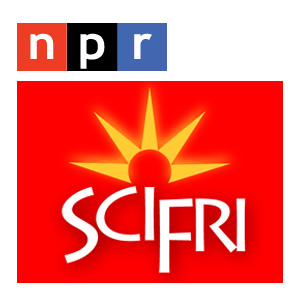 Friday, March 5th, 2010
Friday, March 5th, 2010
Nuclear Technologies
From small-scale nuclear power plants to advanced reactor designs, what's next for the technology of nuclear power? We'll talk about some of the technology changes involved in proposed new reactor designs under consideration by the Nuclear Regulatory Commission. We'll also look at the idea of small-scale nuclear -- building a power plant to support a community, rather than an entire state. Will downsizing make the nuclear any more appealing?
Nuclear engineer Thomas Pigford, former MIT professor, dies at age 87
Helped lay the foundation for MIT's graduate program in nuclear engineering
Former MIT Professor Thomas Harrington Pigford SM '48, ScD ‘52, who helped launch the Institute's graduate program in nuclear engineering, died Sunday, Feb. 28, at his home in Oakland, Calif., from complications of Parkinson's disease. He was 87.
New technique offers a more detailed view of brain activity
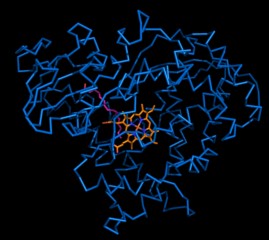 For neuroscientists, one of the best ways to study brain activity is with a scanning technique called functional magnetic resonance imaging (fMRI), which reveals blood flow in the brain.
For neuroscientists, one of the best ways to study brain activity is with a scanning technique called functional magnetic resonance imaging (fMRI), which reveals blood flow in the brain.
However, although fMRI is a powerful tool for identifying brain regions that are active during a particular task, it offers only an indirect view of what's happening. Measuring a more direct indicator of neural activity, such as concentrations of neurotransmitters (brain chemicals that carry messages between neurons) could be much more valuable.
Now, for the first time, MIT and Caltech researchers have come up with a new type of fMRI sensor that can do just that. The two sensors, described in the Feb. 28 online edition of Nature Biotechnology, detect dopamine — a neurotransmitter involved in learning, movement control and many other brain processes.
“This new tool connects molecular phenomena in the nervous system with whole-brain imaging techniques, allowing us to probe very precise processes and relate them to the overall function of the brain and of the organism,” says Alan Jasanoff, an associate professor of biological engineering at MIT and senior author of the paper.
>> Read full article & watch video
Image: A model of the protein Jasanoff's team engineered into a dopamine sensor for MRI
Recent NSE graduate Lara Pierpoint working on energy policy.
The MIT Washington Office likes to connect MIT affiliates who have deep backgrounds in policy-relevant research topics with Washington officials who might benefit from hearing expert opinions. The details of these students' and professors' experiences vary widely, but they share a common theme of working to bolster support for and understand science in the federal government.
Lara M. Pierpoint, a PhD student in the Engineering Systems Division, said she “fell in love with the policy world,” as an undergraduate while interning at the National Academy of Sciences. Enrolling in the Technology and Policy Program and Department of Nuclear Engineering at MIT for her Master's felt natural. She has interacted with policy makers in D.C. in a variety of contexts, including trips with the Technology and Policy program and the MIT Energy Club, which she led as president in the 2008-2009 academic year, and on her own, as an intern at the Department of Energy in the summer of 2006. Pierpoint called the Washington Office an “invaluable resource” during many of her trips to D.C. in part because the staff are “very steeped in whatever is going on [in Washington] at the time.”
>> Read full article
NSE Professor Ron Ballinger and DMSE Professor Ned Thomas lead a team of NSE and DMSE faculty in a collaboration with BP to investigate materials and corrosion science and technology.
BP today announced the launch of a major research collaboration with the Massachusetts Institute of Technology (MIT) and the University of Manchester. BP and the universities will work together on materials and corrosion research, as it applies to oilfield applications. In addition to Prof. Ballinger, other participating NSE faculty include Professors Bilge Yildiz and Sidney Yip. DMSE Professors Michael Demkowicz and Chris Schuh will also play a role.
For MIT, Professor Ron Ballinger noted that "The MIT/BP collaboration is an exciting opportunity to develop a fundamental understanding of the underlying mechanisms of environmental degradation and the application of this understanding to the development of advanced materials for use in extreme environments such as those found in the oil and gas industry." Professor Ned Thomas added, "Advanced energy production systems are increasingly materials limited so it is critical that our graduates are well versed in the role of extreme environments on materials behaviour and, in particular, the role of corrosion in real engineering systems."
As part of this long-term relationship, BP will also fund curriculum development at the two universities in order to help build a higher profile for oilfield materials and corrosion science in undergraduate and graduate education.
>> Read full article
NSE graduate student Saaransh Gulati hopes to power up nuclear energy for the US and developing nations.
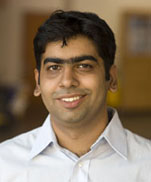 By improving the performance of nuclear power plants, Saaransh Gulati hopes to give nuclear energy a boost, thereby helping meet global energy demands while cutting carbon dioxide emissions that contribute to global warming.
By improving the performance of nuclear power plants, Saaransh Gulati hopes to give nuclear energy a boost, thereby helping meet global energy demands while cutting carbon dioxide emissions that contribute to global warming.
Gulati is one of 47 MIT Energy Fellows supported by MITEI's member companies in 2009-2010. Sponsored by MITEI associate member EDF, Gulati is working with Jacopo Buongiorno, associate professor of nuclear science and engineering, to develop a computational fluid dynamics (CFD) model to predict and improve conditions within nuclear reactors.
>> Read full article
NSE graduate students peer inside an artificial sun
 Nuclear Science and Engineering students Dan Casey, Mario Manuel, and Nareg Sinenian are a part of the research team at MIT's Plasma Science and Fusion Center (PSFC) that has developed techniques to provide detailed images from the inside of the hellishly hot core of advanced fusion experiments.
Nuclear Science and Engineering students Dan Casey, Mario Manuel, and Nareg Sinenian are a part of the research team at MIT's Plasma Science and Fusion Center (PSFC) that has developed techniques to provide detailed images from the inside of the hellishly hot core of advanced fusion experiments.
>> Read full article
